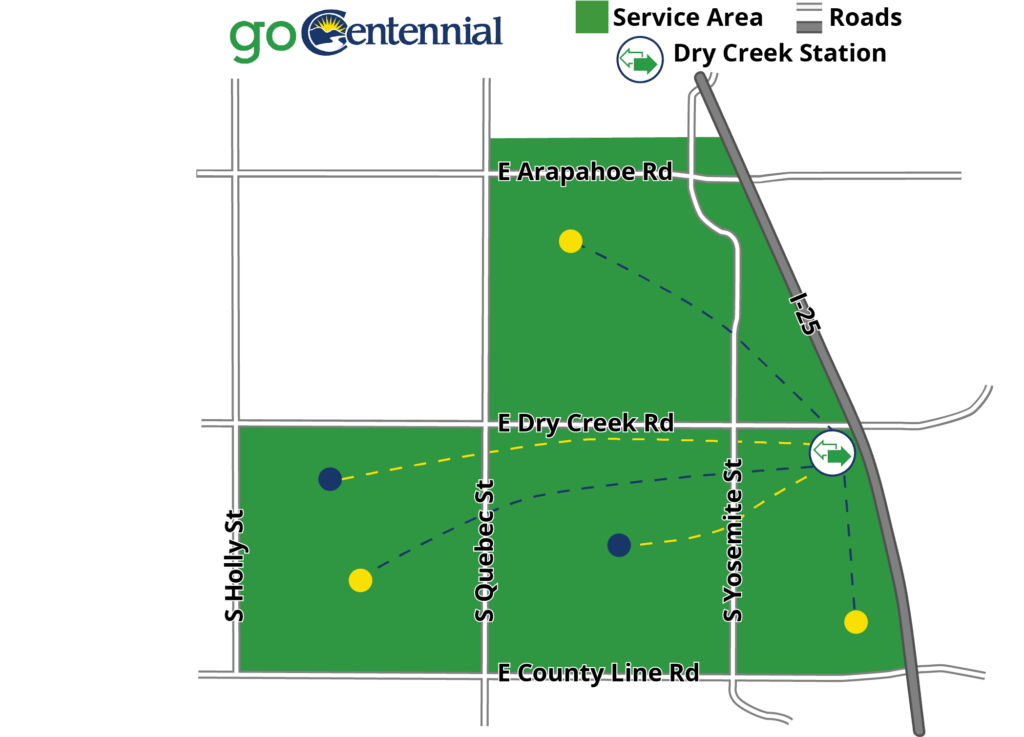Centennial, Colorado and Lyft First/Last Mile Pilot Project Review
20 minutes Author: Shared-Use Mobility Center Date Launched/Enacted: Aug 14, 2017 Date Published: May 30, 2018

Brief Summary
- Bridj is a microtransit company that suddenly discontinued its operations in the United States in 2017.
- Bridj provided on-demand flexible route services to customers in areas like Boston and Kansas City.
- Microtransit is a novel practice in the shared mobility world. Some potential reasons for Bridj’s failure include its capital-intensive business model and lack of public subsidies.
Introduction
From August 2016 to February 2017, the City of Centennial, Colorado operated a pilot program to provide first/last mile connections to transit using an innovative public-private partnership (P3). Now that the Centennial-Lyft pilot project is over, planners are beginning to evaluate it to better understand how it performed and to determine its applicability in other cities.
The final report on the pilot explains the service in greater detail:
To enhance regional transportation and reduce congestion, the City launched Go Centennial, a public-private partnership (PPP) designed as an experiment to enhance and increase transit ridership. For a 6-month pilot period, transit users in a 3.75-square-mile service area near the Dry Creek light rail station, could take a free Lyft Line ride between the light rail station and any point in the service area. An accessible vehicle with a ramp and a trained driver were present in the service area during all hours of operation to provide service for seniors and people with limited mobility. Rides could be booked through smartphone applications or by telephone through the City’s Citizen Response Center (CRC).
The City of Centennial launched the pilot in partnership with the Denver South Transportation Management Association (DSTMA), Southeast Public Improvement Metropolitan District (SPIMD), Lyft, Via Mobility Services (aka “Via”; to provide full ADA accessibility), Xerox (Conduent; trip planning tool) and CH2M, which was contracted to provide public works services.
The report notes that there are 1,530 residents who live in the Dry Creek Call-n-Ride (CnR) area who commute to jobs along the rail line and that there are 680 employees who worked in the pilot project area. Assuming the riders use the light rail for two trips a day, the planners estimated the potential pilot market at 4,600 one-way trips per day. With an assumed seven percent capture rate, the pilot could potentially serve 300 one-way trips per day. At the project’s conclusion, however, the RTD’s report showed that the pilot served only 1,302 total trips, for an average of 10 trips per day.
As illustrated in the table below, it cost the City an average of $48 per trip under the Centennial Lyft pilot project. When comparing that cost to a comparable six-month period in 2015 for the same CnR service area, the average cost was $20.92 per trip for the CnR, less than half of the cost under the pilot project.
| Centennial Lyft Pilot Project Costs | |
| Market Rate Lyft Cost Trip ($5.50 x 1,302 trips) | $7,161 |
| Via Mobility ADA Services Equipped Van for 13.5 hours/Day for 6 Months | $47,000 |
| Xerox (Go Denver) hosting, Data Collection & Analysis | $9,000 |
| Total Costs (excluding other administrative costs) | $63,161 |
| Average Cost/Trip | $48.5 |
(Table 1: Regional Transportation District (RTD) Board of Directors Report, April 2017).
 Figure 1: Centennial Transit Station Aerial Photo (Credit: Google Maps)
Figure 1: Centennial Transit Station Aerial Photo (Credit: Google Maps)
Why Did the Project Not Meet Expectations?
The final report cites several reasons why the Centennial-Lyft pilot did not achieve the intended results. These include:
- The service area was too small, at 3.75 square miles.
- The area did not have adequate population and job density to generate ridership.
- The seven percent capture rate may have been too ambitious for a limited pilot project. (By comparison, the Lone Tree Link shuttle service only captures two percent of the total employee workforce that it serves on a daily basis, and is also subsidized by local employers.)
- Marketing and outreach to inform and attract riders was not sufficient to support a new transportation model.
- The expectations for behavior change among users was too high. Existing commuters would have needed to change their behavior to adopt and use a new service.
However, the riders that the Centennial-Lyft pilot project did attract tended to use the service on a regular basis, indicating that the service could hold long term impacts if perhaps it were differently structured.
Evaluating Future Pilots
Additional factors need to be considered when evaluating the success of this project and its application in other areas. These include the current employee transportation mode split, and whether or not a pilot is replacing a current program or enhancing existing service. While the ridership was indeed lower than projected, the final report noted that the City and its partners were able to demonstrate a successful public-private partnership that addressed a latent demand with a responsive service.
The report authors also note that the expansion of the study area would allow the accessible vehicle to cover a greater area, and perhaps lower the per-ride cost. Finally, future programs should aggressively market their programs to users and companies, and by creating greater visibility in the right-of-way by creating marked pick-up/drop-off spaces.
For more information, please access the Centennial-Lyft final report released in June 2017.